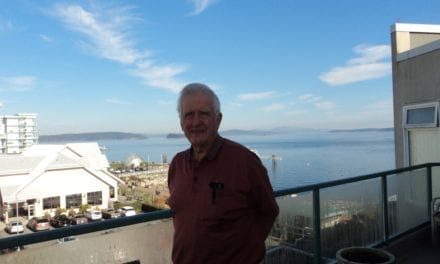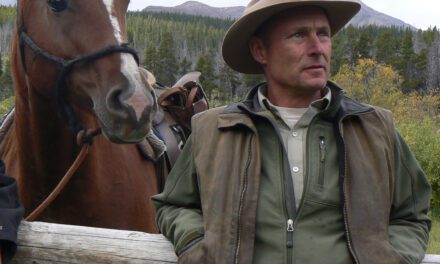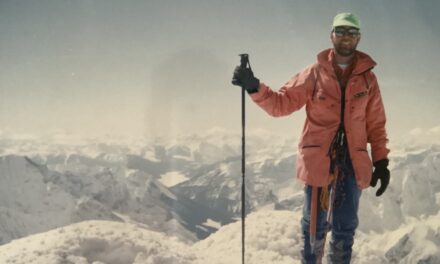SH: That was a great story. I didn’t know that one.
Dave: Who else …. Johnny Nylund – Johnny was great horseman. He probably had more horse knowledge that anyone I ran into. He seemed to understand horses, and he knew how they think. If you listened to him he could kind of tell you that. You could learn a lot from him. Other memorable horse people, Cal Hayes at the ranch, Cal was something else. He was not very big but man he had a big personality. I always appreciated Johnny and what you could learn from him with horses. Cal was just a little bantam rooster. He ran that Ya Ha Tinda Ranch like he was a sheriff out there.
I remember one time in the fall, Marc Ledwidge and I were at Scotch Camp. That’s when the road was still in and you could drive in. We were there on the 30th of October, sheep season. We tried to get over Divide Pass to Clearwater and we couldn’t make it over Divide pass so went back to Scotch. And it went to about 34 below that night. Anyway our truck wouldn’t start. So we called out to the ranch and one of the ranch hands came out. We put a chain on the truck and tried to drag the truck around to jump start it. It was so frozen up that the wheels wouldn’t turn, they just skidded on the grass. So we couldn’t even turn it over. So we went back to the Ranch and got a tiger torch. We came out and got the oil pan in the truck red hot. We squirted some ether down the carburetor and it finally started up. We made it out to the ranch just in time for a great big liner truck full of hay arriving. We ended up stuffing the loft of the barn full from this 40 foot flat deck truck full of hay bales. It was cold.
SH: Wow that’s cold for late October.
Dave: Ya it was snapping cold. (Tape 09:51)
Dave: One thing I really appreciated was later, on …. I talked about specialization, working in the wildlife shop with Tom Hurd and Cliff. Some of the projects I got to be involved with. Trapping wolves, radio collaring wolves, that was interesting. The elk project around Banff where we reduced the elk herd, we had a lot of problem elk in the Town of Banff. Catching and trapping the elk, processing them … that was interesting work. It was interesting because you were learning something. It’s easy to fall into a trap in your job when you just do the same things all the time, but that was an opportunity to learn something, and I really appreciated it. One guy that stands out over the years was Mark Hebblewhite, a young fellow, and now a university professor, in Missoula Montana. But at the time he was a master’s student, working on his PhD. One of the smartest guys I’ve ever been around. He could explain really complex ideas and theories, and put it in plain English, that was quite understandable for people without his experience or training. I
really enjoyed working with him. I worked out in the Panther trapping wolves with him.
Dave: We trapped wolves out there in the Panther. One of the things I’m appreciative about my experience in the Warden Service …. I was able to take my daughter with me on many trips. She’s probably got as many miles in the backcountry as just about anybody. I was really thankful I was able to do that. When she was twelve years old, we rode from the ranch to Indianhead, 26 miles. Never heard a whimper or a peep out of her .. she slept well that night. We put in lots of long days like that, chasing after wolves, checking wolf traps.
SH: Yes my kids got some great horse trips too. We were super lucky to have that opportunity.
SH: Is there anything about the Warden Service, as you knew it, that you would want future generations to know? (End of Section – Tape 13:15)
Part 7: 12:51 pm
Dave: Esprit de corps was the big thing for me. As soon as I came on in Jasper I realized that I was working with a very like-minded people. You hired on for a job but instantly had 20 new friends, the kind of people that would have taken you years and years to find individually. But poof, there was a whole bunch of people that had similar interests, and ways of thinking and doing things that you did. All of a sudden they were just there. And they were not only friends, but the people you worked with every day. So, it was enjoyable going to work, the job was nice and you felt like you were accomplishing something, and you were doing it with a bunch of people that you liked. There’s always the odd one, but overall it was good.
SH: Okay so that’s what made the Warden Service such a unique organization as well. So we’ve covered that one. (Tape 01:42)
SH: Do you have any lasting memories as a Warden? Favorite park, cabin, horse, trail, etc.
Dave: I have a favourite horse, Geronimo.
SH: Better than Kelly?
Dave: Better than Kelly. The best horse I ever had in my whole park experience. I ended up getting Geronimo when he was six and I had Geronimo for 11 years. But I had him my entire time, from when he was six years old. I got Geronimo in 1999 in Banff. I moved to Banff from Lake Louise in 1995 and was working in the backcountry. He wasn’t the fastest, I think Kelly was faster, but he was just about as fast. He had the biggest heart. That horse would go all day long and go hard, up hills, he’d charge up. He was a hard working horse. The most reliable horse….you could take him into an old burn and it was like pick up sticks. He’d pick his way through something like that, one step at a time through all this downed timber. You could go anywhere with him. I formed the strongest bond with him of any horse that I was around. He was a great horse.

Dave riding Geronimo in the September 2009 Warden Service Centennial Parade in Banff.
SH: Would he remember you when you came back every year?
Dave: Not only that but I went to the Ya Ha Tinda one time in the spring and they’d been turned out all winter. There was a group of 40 horses out in a big pasture, 40 or 50 acres or so and there a band of 40 horses out there running around. We’re down by the hay pile going up to the Ya Ha Tinda. I got out of the truck and walked out into the field about 100 feet and hollered for him. And out of that whole group that was running around, he stopped and came over to me. I was with Rick Smith at the time, and Rick said, “He obviously knows who you are”. He was a great horse, he was very nervous, very jumpy, I don’t know why. The slightest thing would get him going. When he was young he was like riding on a stick of dynamite. You didn’t quite know if he was going to go or not. He never went intentionally on me but did by accident a couple of times. I didn’t get bucked off but I got hurt one time, with pulled pelvis muscles. He rattled me sideways, so hard, it took me a year to get over that. I should have fallen off but I stayed on instead and got the full effect. He bucked sideways, and he shifted sideways so fast, it just pulled my groin. My hat had blown off in the wind. That got him going. It wasn’t his fault, that was just the way he was. As time went by he got better and better. And then when I left Banff and I went over to Kootenay in 2005, I took him with me.
SH: Oh, you didn’t mention Kootenay Dave. Would you like to talk about Kootenay? (Tape 06:43)
Dave: Not much to be said about Kootenay. I ended up going to Kootenay because at this point we’d lived at Castle Junction for 13 years. That’s where my daughter was raised. Unfortunately the septic field and the well got together. The septic field failed and contaminated the well. I was in the backcountry and got a message that my wife and daughter were living in a motel and that was the end of living in Castle Junction. Parks had no intention of fixing anything because at this point they knew in the future, they were going to be getting rid of all the Warden Stations. They weren’t going to spend any money on it. Nobody was that straight forward and honest about their intentions, but that’s what it was. So we had to get out. We moved to town and lived in Banff for ten months and didn’t like it. So we decided to move to Invermere where we had property. So we hurried up and finished up our house in Invermere. My wife and daughter moved over here (Invermere) and she started school the next fall. I traded with Joe Owchar, who was working in Lake Louise, which is part of Kootenay, Yoho management area now. So we swapped positions and I ended up spending one winter in Lake Louise again. And then the next year, by 2005, they said I could go to Kootenay. I stayed there until I retired in 2010.
Once I moved to Kootenay, for five years, I went on income averaging, and I took the winters off, three months off and a month of annual leave. So, I took December Jan, Feb, March off in the winters for the whole time I was there. Which was good because I still love skiing, so I skied a lot in the winters. I rode again in the summers, so I was kind of back to where I’d started …. skiing in the winters and riding in the summers, with a lot of interesting stops in between but that’s how it ended up. I’m glad I did that. Income averaging was right for me because I don’t think I could have put in a winter in Kootenay. Not a lot happening in Kootenay in the winter, and pretty tough faking it. So rather than fake it I took the time off and I’m glad I did.
SH: Do you ever miss being a Warden? (Tape 10:03)
Dave: No I don’t actually. When I reflect back on it, and this conversation we’ve had, there’s a lot of fine memories, memorable experiences. Even some of the bad ones. You lay a bunch of time on it and they aren’t as bad as you thought. It’s nice to reflect back on it. I’m very thankful and grateful for the opportunity. I was lucky to be part of Parks Canada and the Warden Service at the time I was. My career – I ended up working 33 years. The last ten years were goofy, somewhat distorted because of the direction Parks was going. But you still make the best of it. Between working in the wildlife shop, and the backcountry, and then backcountry out of Kootenay, Yoho that encompassed things like the Rockwall in Kootenay and spent a lot of time in the Cyclone area out of Lake Louise. Probably the highlight of the backcountry stuff was being Acting Backcountry Supervisor when I was in Banff. And that kind of carried out when I was in Kootenay. I wasn’t the Backcountry Supervisor but I was mentoring new wardens, taking them out and show them enough to stay alive, not get hurt and not hurt the horses. Come back in one piece and try to pass on what I’ve learned in the past 30 odd years. Much the same as what Brian Wallace had done for me when I started. That was rewarding. I think back on all the number of faces and people I took out. I can’t count them all. That was satisfying. Knowing that you passed on some skills that kept them from getting hurt.
It’s disappointing now… to see there’s very little horse use in the park anymore. I don’t quite know how Park management runs the park. I don’t think you can do it with trail cameras and Google Earth. I think that’s how they’re trying to do it. One thing about being in the backcountry you got to know the park intimately. You knew everything. You knew the trails and it paid off when people were lost. You knew possibly where they might be, or where they could go wrong and where to look. The intimate details of the whole park, not just the frontcountry part that you can reach in a day. I think it’s important to know the entire park and I think that part of it is being lost. I know it is… (End of Section: Tape 14:20)
Part 8: 1:07 pm
SH: Do you have any photos of yourself as a Warden that you would like to donate to the Project, or that we may copy? Do you have any artifacts/memorabilia that you would like to donate to the Project (Whyte Museum)?
Dave: I’d have to dig around. One thing I do have and it started from the very first day I started in Elk Island. In those days you were required to keep a daily diary and hand it into the Chief Warden on a monthly basis and he reviewed all of them. That started in Elk Island and when I moved to Jasper I kept that up. I’ve got a diary for every year that I’ve worked and for every day that I worked. I have been retired ten years and I’ve always said someday I’m going to go through them and I never have. They are just there in a box.
One thing I wrote down…. They always wanted to know how many hours did you spend doing this, that and the other thing, how many miles did you put on whether it was in a vehicle or on foot or by horse. In the backcountry, every trip I went on, every time I went out I kept track of where I went, who I rode and where I stayed and how many miles I put so. So, I’ve got a record of every mile I’ve ridden on horseback working for national parks. One of these days I’m going to go through the books and add them all up because I’m kind of curious about how far I went. (After the interview Dave read his diaries and calculated the number of miles he rode during his 33-year career as a National Park Warden. Eighteen of these years were backcountry. Dave rode 23,667 kilometers (14,700 miles) of backcountry trails.)
SH: I bet nobody else has that. That’s cool.
Dave: Yes, I’ll know how many miles I did. As a matter of fact, I can do that in the next while.
SH: That would be really neat and I think Marie would like that too. This is going to the Whyte museum and Marie has a copy of everybody’s stories. That would be fascinating.
Dave: Out of 34 summer seasons I spent the best part of 17 of those years in the backcountry. Because my years in Kootenay were all on the trail.



